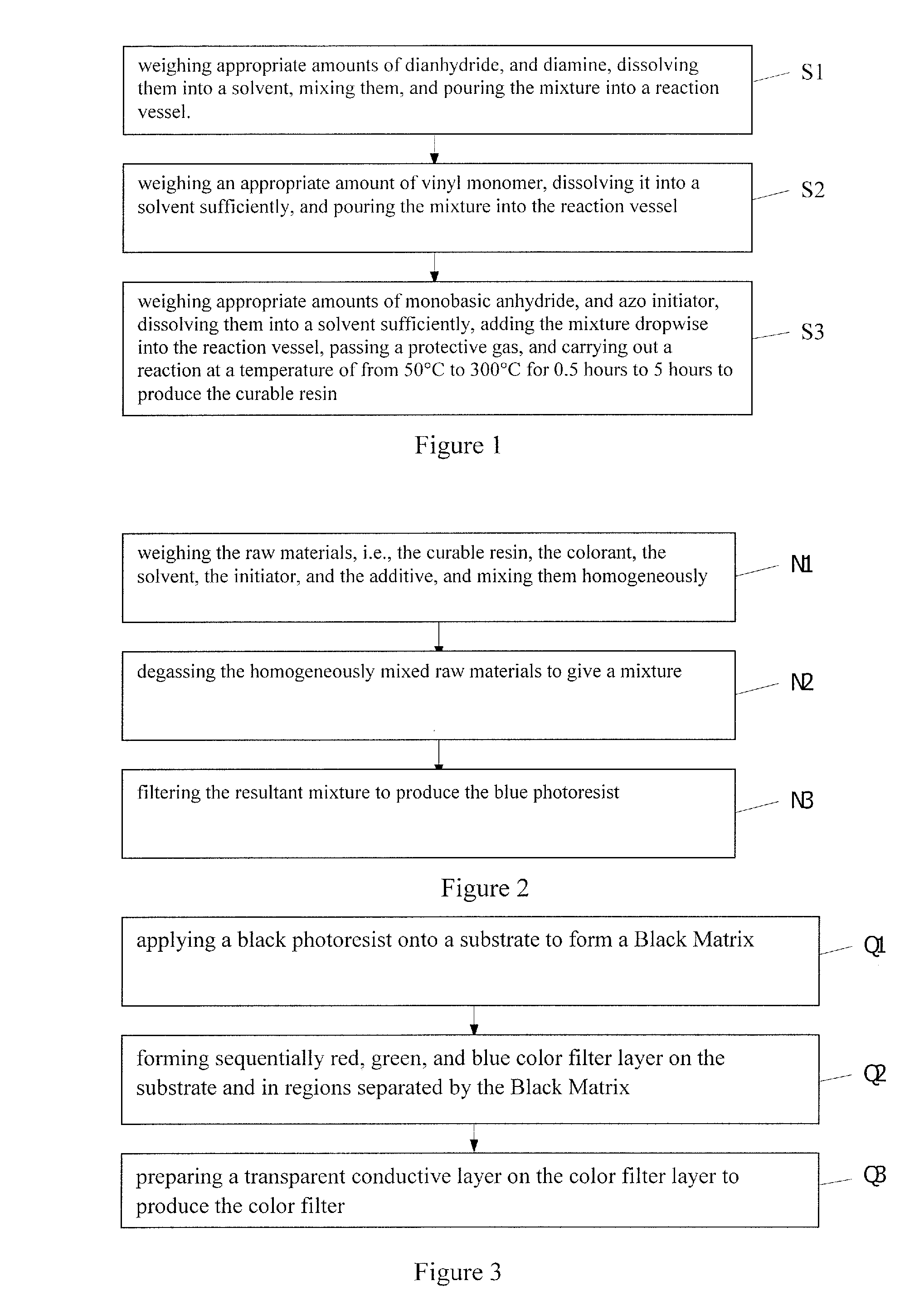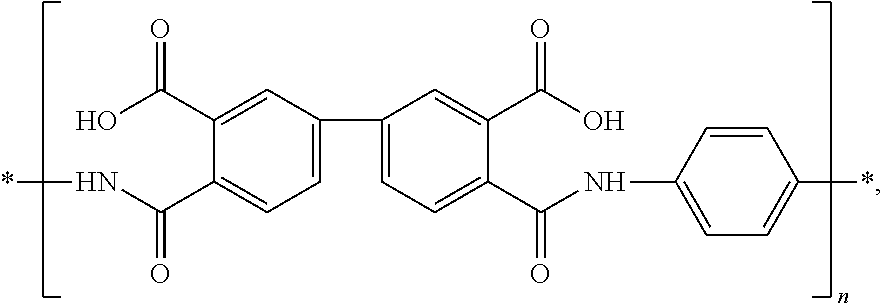Curable resin, blue photoresist, color filter, and methods of preparing the same, and color display device
- Summary
- Abstract
- Description
- Claims
- Application Information
AI Technical Summary
Benefits of technology
Problems solved by technology
Method used
Image
Examples
example 1
Preparation of Curable Resin
[0081]First, 1 part by weight of pyromellitic dianhydride and 0.9 parts by weight of 2,2-bis[4-(4-aminophenoxy)phenyl]hexafluoropropane were weighed and dissolved in 12 parts by weight of ethylene glycol dimethyl ether, mixed sufficiently homogeneously, and poured into a four-neck flash equipped with a heating device, a reflux device, a stirring device, and a dropping device. Then, 2 parts by weight of was weighed and dissolved sufficiently in 4.5 parts by weight of cyclohexane, and poured into the reaction vessel. Finally, 0.3 parts by weight of 4-hydroxyphthalic anhydride and 0.04 parts by weight of 2,2′-Azobis-(2-methylbutyronitrile) (AMBN) were weighed and dissolved sufficiently in 2.7 parts by weight of ethylene glycol dimethyl ether, and added dropwise into the four-neck flask. Nitrogen was passed into the reaction vessel. The reaction ran at a temperature of 120° C. for 3 hours to produce the curable resin.
[0082]The curable resin was analyzed by ge...
example 2
Preparation of Curable Resin
[0085]First, 1 part by weight of trimellitic anhydride and 1.2 parts by weight of 2,2-bis[4-(4-aminophenoxy)phenyl]hexafluoropropane were weighed and dissolved in 15 parts by weight of 1,1,1-trichloroethane, mixed sufficiently homogeneously, and poured into a four-neck flask equipped with a heating device, a reflux device, a stirring device, and a dropping device. Then, 2.4 parts by weight of methyl acrylate was weighed and dissolved sufficiently in 6.5 parts by weight of cyclohexane, and also poured into the reaction vessel. Finally, 0.5 parts by weight of nitrophthalic anhydride and 0.05 parts by weight of AMBN were weighed and dissolved sufficiently in 2.5 parts by weight of 1,1,1-trichloroethane, added dropwise into the four-neck flask. Nitrogen was passed into the reaction vessel. The reaction ran at a temperature of 160° C. for 2.5 hours to produce the curable resin.
[0086]The curable resin was analyzed by gel permeation chromatograph to find: the mo...
example 3
Preparation of Curable Resin
[0089]First, 1 parts by weight of benzophenone tetracarboxylic dianhydride and 1.4 parts by weight of 2,2-bis[4-(4-aminophenoxy)phenyl]hexafluoropropane were weighed and dissolved in 18 parts by weight of dichloromethane, mixed sufficiently homogeneously and poured into a four-neck flask equipped with a heating device, a reflux device, a stirring device, and a dropping device. Then, 3 parts by weight of maleimide was weighed and dissolved sufficiently in 10 parts by weight of cyclohexane, and also poured into the reaction vessel. Finally, 0.65 parts by weight of 4-hydroxyphthalic anhydride and 0.06 parts by weight of AMBN were sufficiently dissolved in 3.2 parts by weight of dichloromethane, and added dropwise into the four-neck flask. Nitrogen was passed into the reaction vessel. The reaction ran at a temperature of 180° C. for 1.5 hours to produce the curable resin.
[0090]The curable resin was analyzed by gel permeation chromatograph to find: the molecul...
PUM
| Property | Measurement | Unit |
|---|---|---|
| Temperature | aaaaa | aaaaa |
| Temperature | aaaaa | aaaaa |
| Temperature | aaaaa | aaaaa |
Abstract
Description
Claims
Application Information
 Login to View More
Login to View More - R&D
- Intellectual Property
- Life Sciences
- Materials
- Tech Scout
- Unparalleled Data Quality
- Higher Quality Content
- 60% Fewer Hallucinations
Browse by: Latest US Patents, China's latest patents, Technical Efficacy Thesaurus, Application Domain, Technology Topic, Popular Technical Reports.
© 2025 PatSnap. All rights reserved.Legal|Privacy policy|Modern Slavery Act Transparency Statement|Sitemap|About US| Contact US: help@patsnap.com


